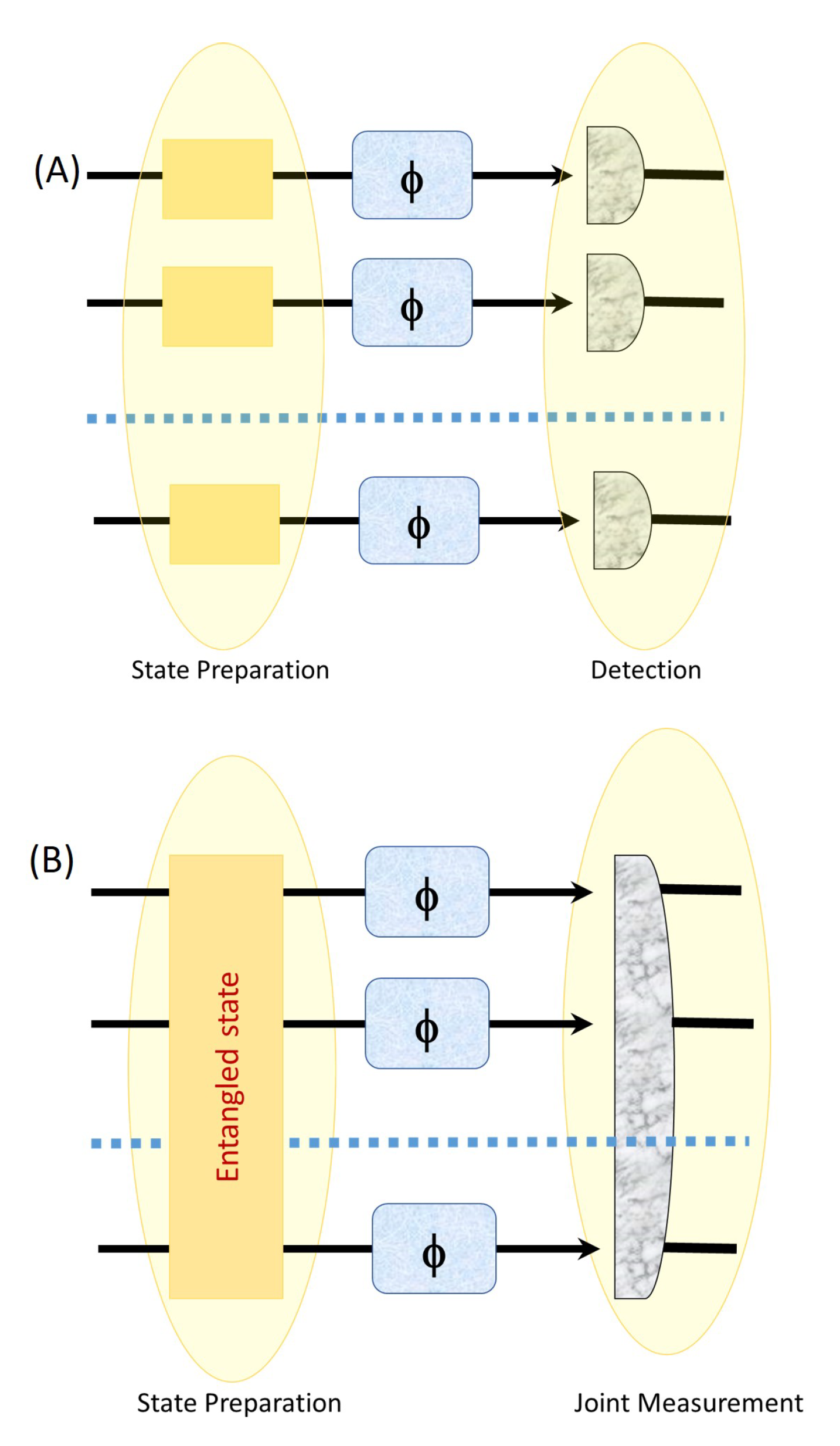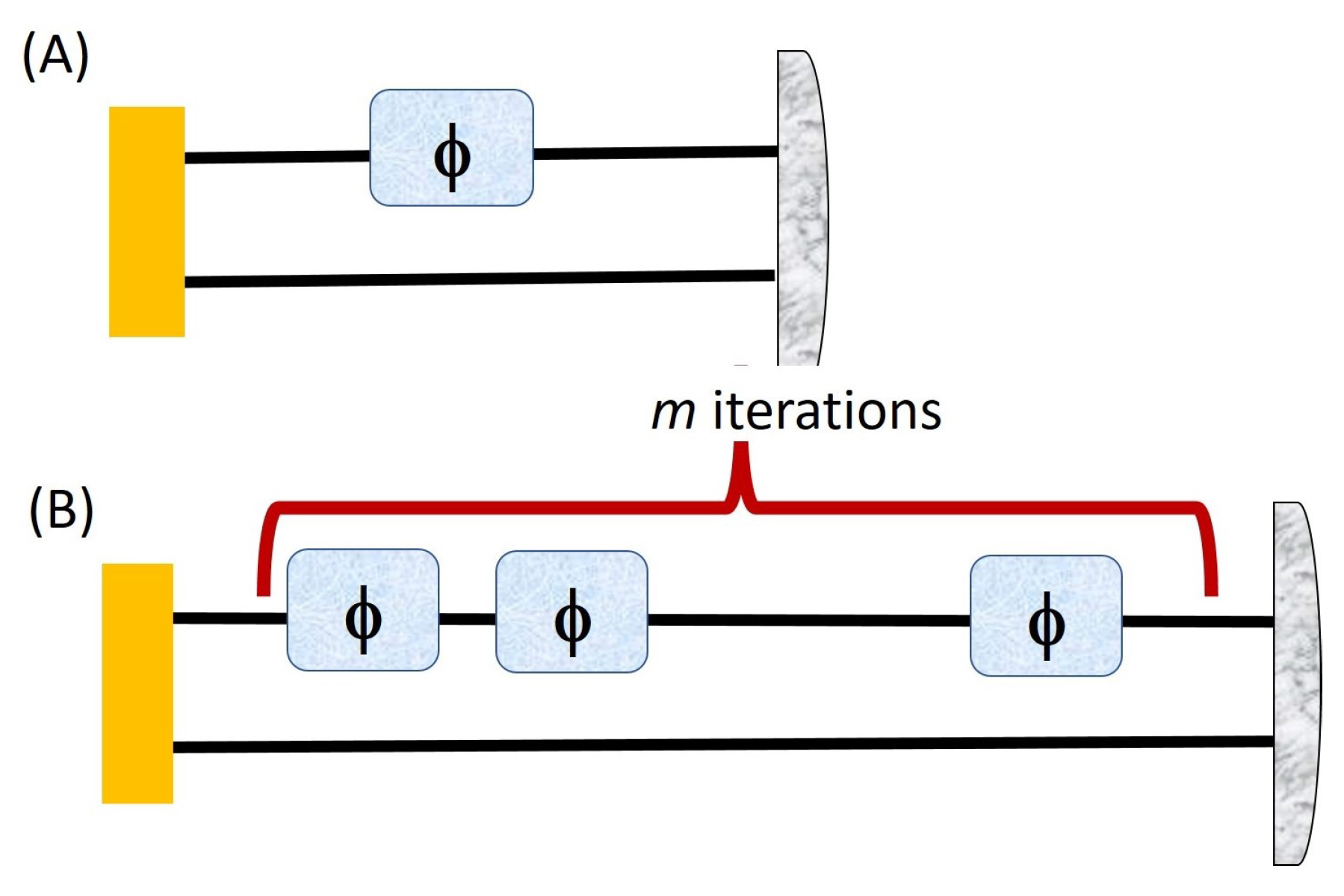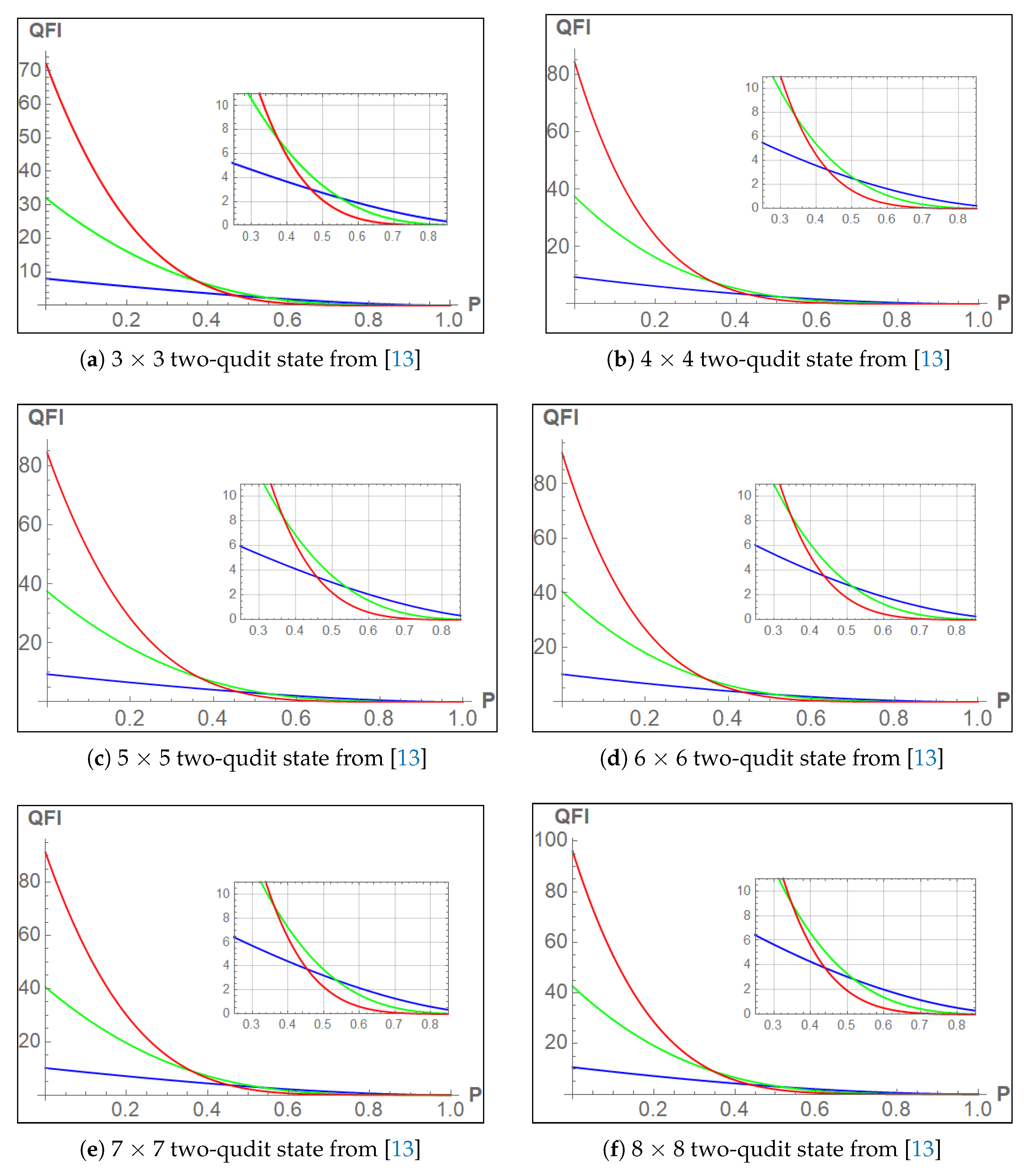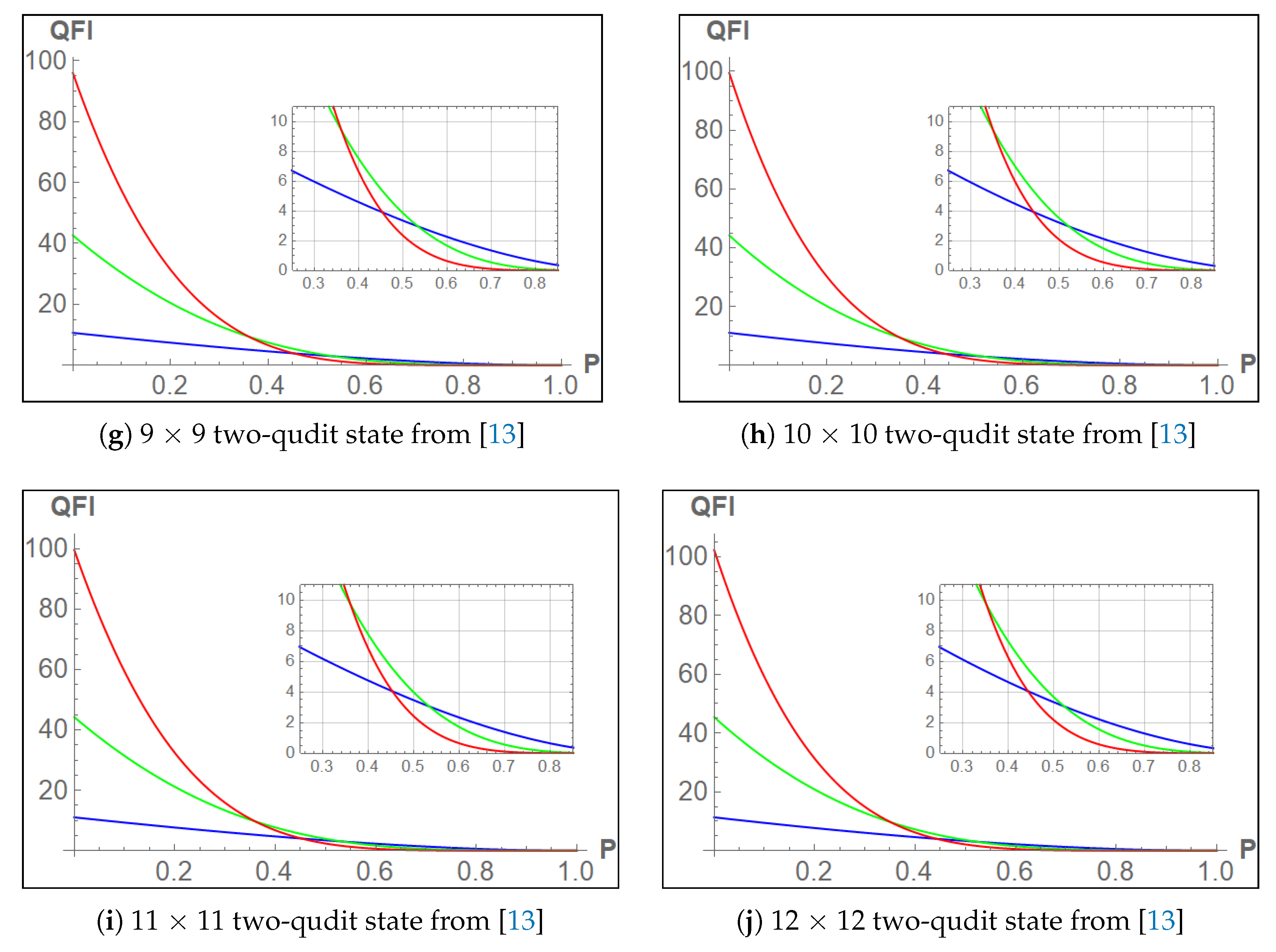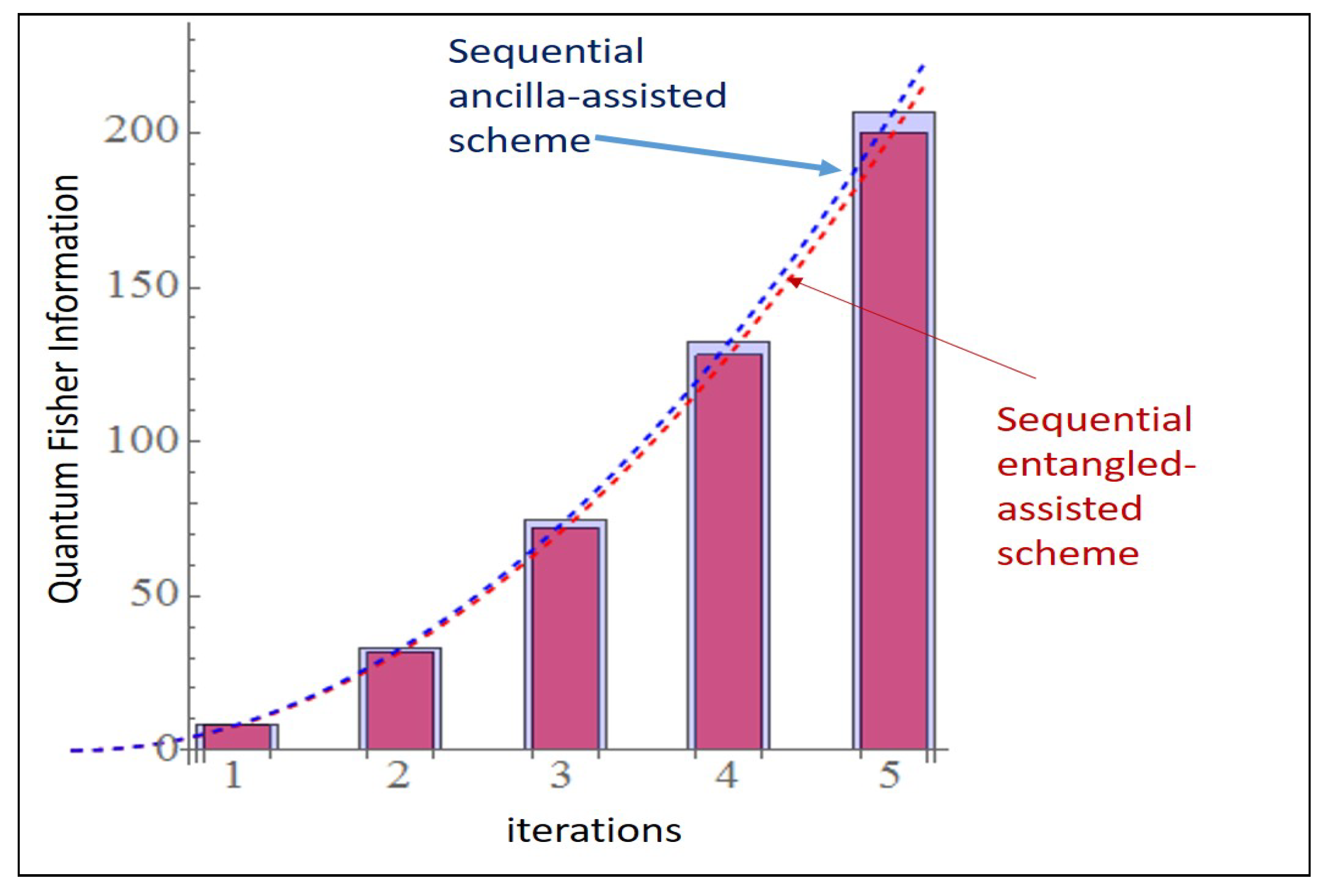1. Introduction to Quantum Estimation Theory
Measurements underline all physical processes [
1,
2,
3]. Yet, like all quantum processes, they is dictated by the laws of physics: Heisenberg-limited sensitivity. In optical interferometry, one such resource is the deployment of
N maximally entangled probes in a NOON state [
4,
5,
6].
Typically there are many quantities we cannot measure directly. A protocol for such measurements is typically indirect where we use an additional probe system to interact with the one under investigation. Due to interaction, the probe gains adequate information about the parameter we want to measure. We then inspect the probe arising from the measurement, and on the basis of the obtained data, we estimate the desired parameter. In order to obtain the highest possible accuracy for the estimation, we perform the experiment repeatedly a multiple of times or, equivalently, make a multipartite probe to interact with the system.
For a classical probe that contains n particles (we can also consider it a measurement performed n times) accuracy scales as , which is the so-called shot-noise limit (SNL). However, if the system is in a particular entangled state, then accuracy can be improved up to a precision of . This limit, called the Heisenberg limit (HL), provides the best accuracy allowed by quantum mechanics. Both of these bounds can be derived from the quantum Cramer-Rao bound with quantum Fisher information (QFI).
Quantum entanglement [
7,
8] has been an extremely useful resource for numerous applications. Reference [
3] reviews quantum metrology using many well known examples of entangled states such as the GHZ state, Dicke state and singlet state and alo describe the highest achievable precision using these states. The Peres-Horodecki theorem [
9,
10] provides a criterion for determining the entanglement of quantum states. If the partial transpose of a mixed state has negative eigenvalues, then the state is entangled. However, in general, we cannot say anything about the entanglement of a state if it does not have negative eigenvalues. It turns out that it is possible in
(
) dimension for the quantum state to be entangled even if the eigenvalues of the partial transpose are all positive. Moreover, these states cannot be distilled to a singlet form and they are also known as bound entangled or positive partial transpose (PPT) states. However, bound or PPT states cannot be distilled to singlets, so these states are not suitable as a resource for quantum communications. Yet, these states can be pumped into Werner state (an admixture of singlet and maximally mixed state) to increase its singlet fractions [
11]. Moreover, PPT states can enhance the ability for teleportation of other states [
12] and they are found to be useful for quantum metrology [
13,
14]. The paper [
14] shows that there are PPT states that are not directly useful for metrology. However, their metrological usefulness can be activated by using two or more copies of these states for the activation. In [
15] the authors provided an inequality based on QFI which must be satisfied by separable states and violation of that inequality can immediately detect bound entangled or freely entangled states, e.g., states found in [
13] will violate that inequality. In [
16] the authors found another class of PPT states with a high Schmidt number for general
dimension states with
, the metrological usefulness of such states are yet to be found.
In
Section 2, we briefly describe Quantum Fisher Information (QFI) along with some useful properties.
Section 3 compares classical and quantum strategies for metrology where the quantum strategies take advantage of entanglement by employing the use of entangled probes for improving QFI. In
Section 4 we discuss at length the effect of using sequential strategies in improving QFI for the PPT states found in reference [
13]. Next, in
Section 5 we apply the sequential ancilla assisted strategy to a family of even dimensional PPT states from [
17] and draw some inferences based on the improvement obtained in QFI. In
Section 6 we apply the sequential approach to both entanglement and ancilla assisted strategies for the case of
and
PPT states and find that this approach gives an improved QFI for the cases considered. Finally, we discuss some implications of our results in
Section 7.
2. Quantum Fisher Information
Fisher information was originally introduced for statistical estimation purposes. The classic Cramér-Rao inequality places an upper bound on the precision of the estimation in terms of Fisher information. Alternatively, this may be interpreted as that Fisher information has a lower bound in terms of the precision (variance) of any measurement. Fisher information has been generalized to quantum situation, and there is also a quantum analogue of the Cramér-Rao inequality [
18,
19,
20].
where
is the Quantum Fisher information (QFI). The quantum Fisher information, a central quantity in quantum metrology, is defined by the formula
Equation (
2) can also be written in the form below using Baker–Campbell–Hausdorff formula
So, Equation (
2) becomes
where, A =
and
is the single particle operator acting on the
nth particle of the probe system also known as the unbiased estimator.
and
are the respective eigenvalues and eigen vectors of the density matrix
, that is used as a probe state for estimating
.
For qubits, the
’s operators are just the spin operators in the
z-direction,
so that A =
but for
, i.e., qudits A =
, where
’s are traditional Pauli operators and D = Diagonal [1,1,...,−1,−1], for even ’d’ there will be d/2 (+1)’s and d/2 (−1)’s and for odd ‘d’ there are
(+1)’s and
(−1)’s, e.g., for a bipartite
qutrit state
where
, and
and
are called local Hamiltonians.
For separable multi-qubit states, the quantum Fisher information, characterizing the maximal precision achievable by a quantum state, is bounded as
where
N is the number of subsystems.
For separable multi-qudit (
) states, the maximum quantum Fisher information is bounded as
where
and
are the maximum and minimum eigenvalues of
.
Quantum Fisher information possesses some interesting mathematical properties [
18]. Indeed, it has been shown that, amongst all generalized analogues of quantum Fisher information, the quantum Fisher information is the largest for rank-2 density matrices and for operators that have zero diagonal elements in the eigenbasis of the density matrix [
21,
22]. Here, we list some of the properties below [
23,
24]:
For pure state the QFI is given by .
is convex in the state , i.e., .
.
For
N-qubit separable states, the values of
for
are bounded as
in Equation (
3) the range is given for one of the
l’s among
.
For Greenberger-Horne-Zeilinger states (GHZ states) (maximally entangled states), the quantum Fisher information is bounded by
For
N-qubit
k-producible states states, the quantum Fisher information is bounded by
4. Sequential Strategies
In this section, we study the usefulness of the PPT two-qudit states introduced in reference [
13] for quantum metrology. These states were shown to be useful for quantum metrology through a semidefinite program, which is essentially a convex optimization algorithm where the constraints are
and
for all
k and
. We first discuss the case in which both the qudits in the input PPT states undergoes a phase transformation so that the qudits in state are imprinted with a phase, and then we subject the state to two specific cases: (A) and (B) in
Figure 2. Cases (A) and (B) have also been studied in reference [
13] for maximally entangled states. In case (B), the authors in reference [
13] studied a noisy state of the form
where
is the total depolarizing noise acting on both the subsystems of
Figure 2B. If the same noisy channel acts repeatedly
m times to the intermediate output state
before the measurement then the final output state becomes
where
is the
PPT state and
p is the strength of noise. It has been shown that as the dimension
d increases, the Fisher information increases (even though the Fisher information for a separable state remains at 8, and also that the noise resistance increases, i.e., the critical
p, when the Fisher information falls below 8, increases as shown in
Table 1 [
13].
In
Figure 3, we present a change in the strategy from the left one (entangled assisted strategy) to the right (sequential ancilla assisted strategy)) where we show that it is possible to increase the advantage by using sequential strategy. We also present the
Table 1 where we apply the sequential strategy to the
to
PPT states in reference [
13] and compute Fisher information for each of the states corresponding to both of the cases of
Figure 3.
Here, the phase is imprinted using the unitary evolution on each of the qudits where where for even dimensions, there are an equal number of −1 and 1 but for odd dimensions, the number of 1 is exactly one more than the number of −1. It is very important to notice that all ’s are local unitary operations acting on each of the subsystems independently, i.e., in the left figure on both the subsystems the local unitary operator acts as (for the upper subsystem) and (for the second one) respectively.
In the right figure, the total operator in Equation (
5) is changed to
where
and
are now same (
) in this case.
For experimentally implementing the sequential strategy using the operator (
13), the unknown phase parameter (
) can be pictured as being applied twice to just one of the two subsystems of the input probe through local unitary
, unlike the case of Equation (
5), where the parameter (locally) is inserted at both the subsystems of the input probe. The operator ‘A’ can be broken as
and
being applied separately to each probe as in Equation (
5) or being applied to the same probe as in Equation (
13). This is mathematically equivalent to two local unitary operations
and
acting on the input probe in the left figure of
Figure 3 and two consecutive local unitary operations
and
acting on the input probe in the right figure of
Figure 3.
In the figures below, we show that we can apply our sequential strategy to both the left and right cases of
Figure 2.
Figure 4A,B shows a sequential process of phase imprinting without (A) and with noise (B) performed repeatedly for
m iterations.
Figure 5 shows the ancilla assisted strategy in which the phase is imprinted once (A) and
m times (B) on the state before measurement. The Fisher information in
Figure 5A in which the phase is encoded just on one of the qudit is a lot less than the Fisher information for a separable state. However, we can perform the sequential strategy to boost the quantum Fisher information as in
Figure 3.
To see why, we find the QFI in which the phase is encoded
m times. If we denote the Fisher information for just one iteration,
, as
, then the Fisher information after the second iteration is
. In this way, if we iterate the same process
m times then the Fisher information after the
mth iteration becomes
Suppose we can now introduce noise in the system. If the noise acts just one subsystem in a bipartite qudit (
) system, it turns out that the noise model is not so trivial. This is not the case for
. The one-qubit Pauli channel for a bipartite qubit system can be written as
When the dimension of the system increases beyond
, the number of generators for SU(
d) increases as
. In particular, for
, there are a total of 8 spin observables. For
, the channel can be extremely complex and it is no longer trivial to describe the channel in tersm of suitable Kraus’ operators. The detailed calculations about the noisy quantum channel is given in
Appendix A.
In all the plots below, in
Figure 6 we are basically using both Equations (
12) and (
14) combined with
in each case and depolarizing noise in Equation (
11) and the highlighted region inside the plots are the intersections of the three iterations. Finally we study how
varies with the noise parameter.
With
m = 3. Now the noise strength is of the order
in
as the noise along with the phase is iterating m times. It can be realized analytically. In Equation (
16) the
takes that particular form because the noisy channel in Equation (
11) and the unitary transformation
commutes so the order between them doesn’t matter.
In the table below we compare our results (in 4th column) with the results(in 3rd column) from reference [
13] with the same optimal states taken from reference [
13].
From the
Table 1 it is clear that not all PPT states from reference [
13] give a higher QFI for the sequential assisted strategy as compared to the entangled assisted strategy (see column 3 and 4), however it can be seen that odd dimensional PPT states (along with the case of
) give higher QFI. Another thing to notice is that the classical Fisher information remains the same in each case. This observation is visually depicted in the bar plot
Figure 7 below.
5. A Family of Even Dimensional PPT States Having a Higher Fisher Information for Sequential Ancilla Assisted Strategy Compared to Entanglement Assisted Strategy
In this section we highlight the advantage of using the sequential ancilla assisted strategy by showing that the family of bipartite even dimensional states recently introduced in reference [
17] shows an improvement in the Fisher information as compared to the entanglement assisted strategy. The family of
dimensional states is given as:
with
,
and
being the matrix elements of a unitary operator acting on a
d dimensional space such that
. The authors, in [
17], also noted that only the
PPT state used in [
13] is related to the family of states
(for
) through a local unitary transformation. For this family
, there are
eigenvectors for the eigenvalue
given by;
There are
d eigenvectors for the eigenvalue
given by;
All other eigenvectors are associated with the zero eigenvalue and they are orthogonal to the ones mentioned above. These set of eigenvectors comprises of vectors having a similar form as
and
but with a sign difference, given by;
and
According to their statement if we consider as the optimal operator for the family of states then we will have Fisher information , which is the maximum we can get.
However, it is easy to see that the sequential ancilla assisted operator
(for two successive iterations) gives the quantum Fisher information exactly
for the family
for all
d, which clearly shows the advantage of using sequential ancilla assisted scheme. This observation matches the findings in
Table 1 where we obtain a QFI of 16 for the
state; however, we do not find any improvement in Fisher information for other even dimensional PPT states of
Table 1 which suggests that those even dimensional states are not related to the family
by any local unitary operation.
7. Discussion and Conclusions
In this paper, we identified the advantages of iteration for improving the Quantum Fisher Information (QFI) in entanglement and ancilla assisted strategies for PPT entangled states. We implemented such sequential strategies for PPT states for various dimensions and found that QFI increases quadratically with number of iterations in the noiseless case as shown in
Figure 9. In the
Section 4, we show the effect of iterations in the noisy cases for 1, 2 and 3 iterations for the entangled assisted strategies.
Further, we reiterate the fact that sequential strategies are completely distinct from a repetition of the experiments through multiple times. Repeating the same experiment say
n times gives the effective Quantum Fisher Information
, where
is the Fisher information for the experiment performed at first time while the sequential strategies shown here give an effective QFI
after
m iterations, where
is the Fisher information at first iteration (if we consider the circuit in
Figure 2 as 1st iteration). This highlights the fact that iterating strategies give an advantage over repetition of the experiment. However, we can always combine the repetition and iteration simultaneously, in such case the total Fisher information after
m sequence of unitaries and
n repetition of the experiment
.
So far we have discussed only PPT states that are useful for metrology, but still there are PPT states that have no use in precision measurement. One such example is Equation (
4), known as the Horodecki state of [
11], in reference [
11] and parametrized as
where
is given by
s = spin of the system = 3 and the
,
are given as
The state in Equation (
24) gives maximum Fisher information in the Bound entangled region (
) for the operator in Equation (
5), of
4.05, which is less than that of separable state
. Even if we use sequential operator in Equation (
13), the max
5 and remains less than the seperable one.
